Kristine Hughes's Blog, page 71
September 3, 2015
THE DUKE OF WELLINGTON TOUR: WHAT KRISTINE SAW FROM THE COACH WINDOW: DOVER TO BRIGHTON
Published on September 03, 2015 23:30
September 2, 2015
DINNER WITH THE DUKE OF WELLINGTON
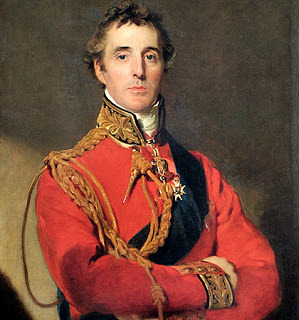
On November 19, 2015, I shall be dining with the Duke of Wellington in Philadelphia. I say this to people - people I know but who aren't au fait with British history - and in response, they look at me askance whilst uttering a nervous laugh. "Right," they say, "the Duke of, er, whatever. Right. Nice. So, er, I'm just going to go and . . . . ." They think I'm nuts. I say the same thing to people who are on point as far as British history is concerned and they say, "Oh, you're a card! The Duke of Wellington. Right! Har Har!" Followed again, for the most part, by nervous laughter.
As though I would lie about the Duke of Wellington. Me. Lie about the Duke. I ask you!? Okay, so I won't be dining with that Duke, but rather this Duke - Charles Wellesley, the 9th Duke of Wellington.

And whilst I'll be dining with the Duke, so will about one hundred others. Honestly, here's the link to the event, which is actually a lecture by the Duke followed by dinner. Victoria was otherwise engaged, so I roped Hubby into agreeing to travel to Philadelphia and attend the event with me. Now you can cue the nervous laughter.
Tickets to the event have been secured. Flights booked. Hotel room the same. Done and dusted. Now all that's left to worry about is the night itself. Many people have dined with many Dukes of Wellington and, as far as I know, all of them have survived. Mrs. Arbuthnot and Lady Shelley dined with the first Duke many times and they came out alright. Queens and Kings have dined with subsequent Dukes of Wellington and emerged unscathed. It's not the dining, or even the minute long meeting, with the Duke of Wellington that concerns me. Well, okay, Hubby meeting the Duke of Wellington does concern me, but personally I'm in a quandry as to what to wear. What does one wear to meet the Duke of Wellington? Or any Duke, for that matter. The event details say, "Formal Business Attire." I can understand this as far as men are concerned, but what about women? Surely something more than a severe skirt and jacket is warranted for an evening event with the Duke?
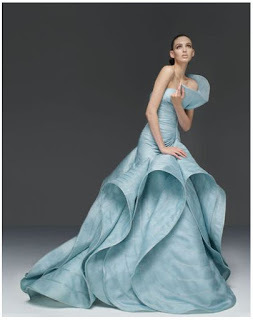
Granted, this might be a tad too much . . . . . .

But on the other hand, surely this is too little?

Is this more like it? Or am I still off base?

I suppose I could always follow the Royal lead . . . . . but then I'd have to find a hat. Sigh.
What to wear, what to wear? It's a quandry and it's distracting. So distracting, in fact, that I'm not even worrying about how in the world I'm going to get Hubby into anything resembling "formal business attire."
Please do leave a comment as to proper attire. I'd welcome the input. Hints, tips and tricks on how to get Hubby to agree to don a suit and tie when no one he knows has died would be likewise appreciated.
Published on September 02, 2015 07:26
August 31, 2015
JOHN SINGER SARGENT AT THE METROPOLITAN MUSEUM OF ART
JOHN SINGER SARGENT AT THE METROPOLITAN MUSEUM OF ART
Victoria here reporting on my recent visit to the wonderful exhibition at the Met, which was shown at the National Portrait Gallery in London last winter and spring..
 detail of Villa Torloni
detail of Villa Torloni
From the introduction by the Met:
Throughout his career, the celebrated American painter John Singer Sargent (1856–1925) created portraits of artists, writers, actors, and musicians, many of whom were his close friends. Because these works were rarely commissioned, he was free to create images that were more radical than those he made for paying clients. He often posed these sitters informally—in the act of painting, singing, or performing, for example. Together, the portraits constitute a group of experimental paintings and drawings—some of them highly charged, others sensual, and some of them intimate, witty, or idiosyncratic. The exhibition Sargent: Portraits of Artists and Friends , which opened at The Metropolitan Museum of Art on June 30, brings together about 90 of these distinctive portraits, including numerous loans from private collections. It will also explore in depth the friendships between Sargent and those who posed for him as well as the significance of these relationships to his life and art.
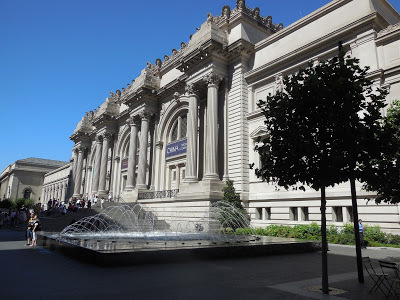 Metropolitan Museum of Art, Fifth Avenue
Metropolitan Museum of Art, Fifth Avenue
I never tire of re-visiting the Met, and it is alwlays fun to snap new angles of the building.
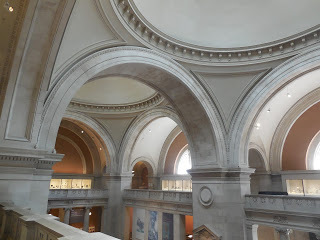
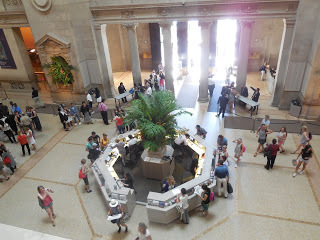
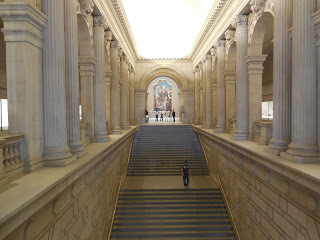
On my way to the special exhibition, I encountered several posters, including a weirdly striking image from a photography exhibition.
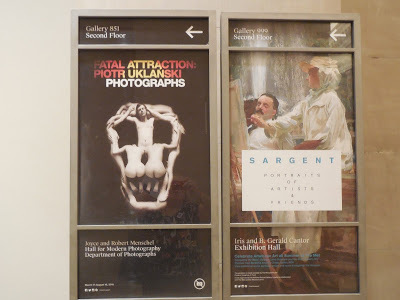
Sargent was born of American parents in Florence, Italy, in 1856. He is best known for his portraits, in the grand traditions of Van Dyke, Reynolds, Gainsborough, and Lawrence. Like their work, his vivid portrayals of the rich and privileged, including their jewels, sumptuously painted fabrics, and noble backgrounds,were perfect for royalty. But these pictures are somewhat different, more experimental, even intimate. The people he painted in these works are his friends and colleagues, fellow members of the intellectual, theatrical, and artistic elite.
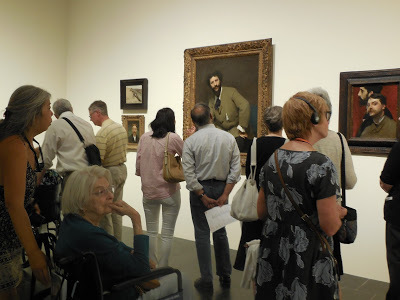 Eager viewers around Sargent's portrait of Carolus-Durand, .
Eager viewers around Sargent's portrait of Carolus-Durand, .
Early in the show is the portrait of Charles-Emile-Auguste Durand (1837-1917). with whom Sargent studied painting, beginning in 1874. According to the text panel, when this portrait of Durand by Sargent was exhibited at the Paris Salon in 1879, some remarked, "the student had surpassed the master."
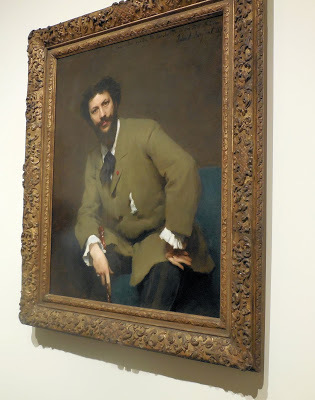 Carolus-Durand, 1879
Carolus-Durand, 1879
Sargent painted the Pailleron family soon thereafter. The father was a playwright, the mother from an influential cultural family in France, and the daughter a literary figure much later.
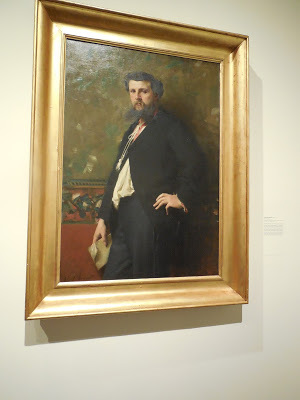 Edouard Pailleron, 1879
Edouard Pailleron, 1879
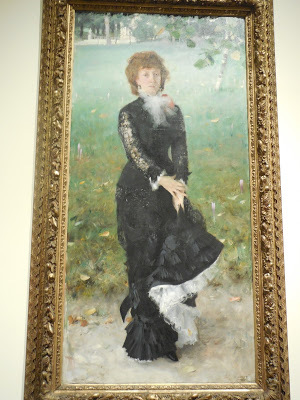 Madame Edouard Pailleron, 1879
Madame Edouard Pailleron, 1879
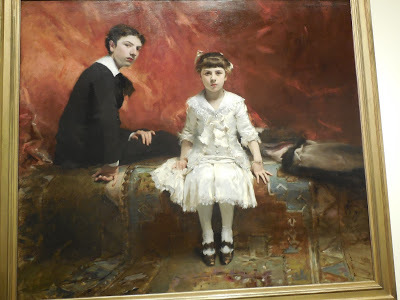 Edouard and Marie-Louise Pailleron, 1881
Edouard and Marie-Louise Pailleron, 1881
This is an unusual double portrait, According to the text panel, "Sargent captures the young girl's disquieting intensity in an image that departs from the conventional Victorian representation of children, Her brother, seated at an angle on the far side of the settee, seems a secondary presence."
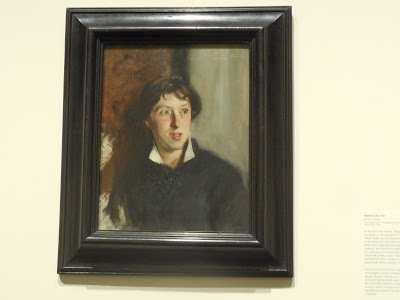 Vernon Lee, 1881
Vernon Lee, 1881
Using a pen name, Sargent's friend Violet Paget, was a "noted feminist and pacifist" as well a a woman of letters.publishing on aesthetics and psychology as well as authoring plays and novels.
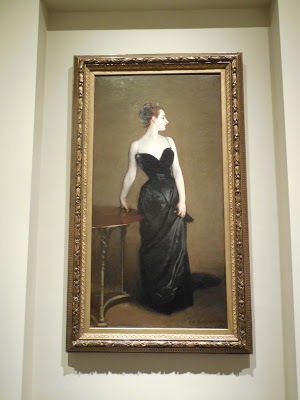 Madame X (Madame Pierre Gautreau) 1883-84
Madame X (Madame Pierre Gautreau) 1883-84
Virginie Avegno Gautreau (1859-1915) from Louisiana was well-known in Parisian society for her daring appearance; Sargent emphasized her glamour in this portrait, which was first exhibited with one shoulder strap slipping down. The Paris Salon of 1884 was scandalized and Sargent re-painted the strap in its 'proper' place. A photograph of the original painting is shown with it.
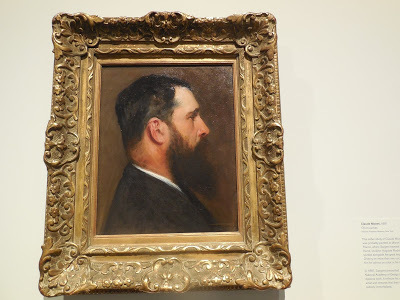 Claude Monet 1887
Claude Monet 1887
Sargent and Monet (1840-1926) were friends and worked together sometimes. After Sargent moved to England in 1885, he followed Monet's example and began to paint outside, often portraying artist friends in a casual setting.
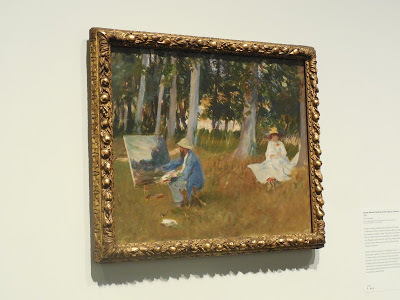 Claude Monet Painting by the Edge of a Wood 1885
Claude Monet Painting by the Edge of a Wood 1885
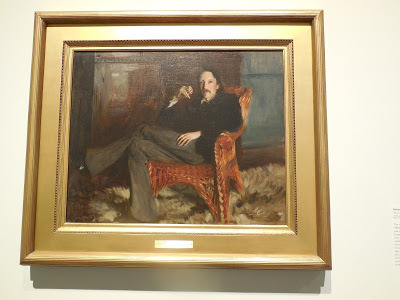 Robert Louis Stevenson, 1887
Robert Louis Stevenson, 1887
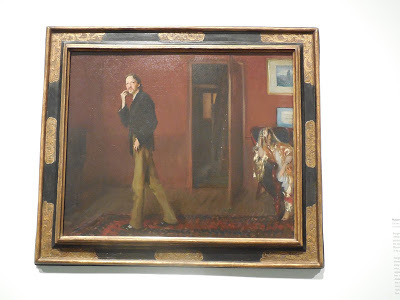 Robert Louis Stevenson ad His Wife, 1885
Robert Louis Stevenson ad His Wife, 1885
Stevenson (1850-1894) and Sargent were friends from early Paris days, and Sargent painted him three times. Of this view, Stevenson wrote it had "that witty touch of Sargent's, but of course it looks damn queer as a whole."
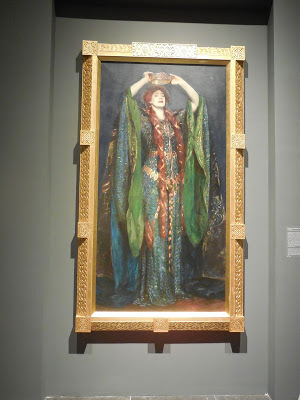 Ellen Terry as Lady Macbeth, 1889
Ellen Terry as Lady Macbeth, 1889
Sargent was impressed with famed Shakespearean actress Terry on the London stage in 1888 and convinced her to pose for him. She is pictured placing a crown on her own head after the murder of Duncan, the Scottish king. From the text panel: "This incident does not occur in Shakespeare's text, nor as it a part of the performance. Sargent, however, sought a dramatic motif to make his portrait convincing, both as the personification of a role,and as a characterization of an individual actor. Terry's intense and powerful gaze enhances the climactic moment."
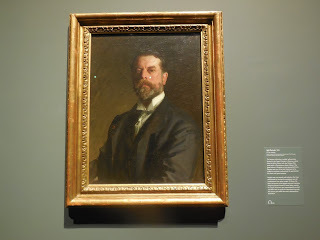 Self-portrait, 1906
Self-portrait, 1906
Sargent was one of the first Americans to be invited to contribute a self-portrait to the collection of the prestigious Uffizi Gallery in Florence."His serious gaze befits the work's distinguished destination."
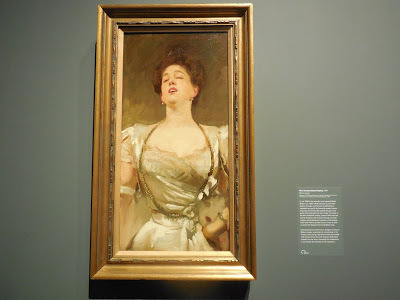 Mrs. George Batten Singing, 1897
Mrs. George Batten Singing, 1897
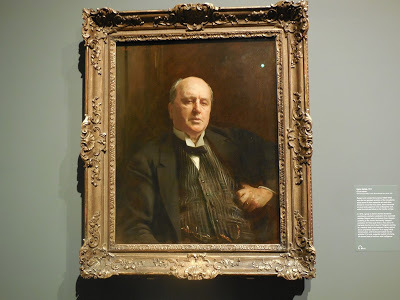 Henry James, 1913
Henry James, 1913
For his own self-portrait and that of Henry James, Sargent chose as sober straight-forward masterful method. When portraying Mrs. Batten singing, he is more creative, emphasizing her rapturous style.
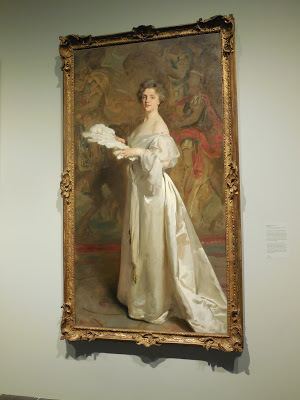 Ada Rehan, 1894-95
Ada Rehan, 1894-95
Another renowned Shakespearean actress, Sargent portrays her in high style. As the text points out, "That Sargent shows her in the grand manner and scale typical of paintings of royalty, points to changing ideas of celebrity in the late nineteenth century."
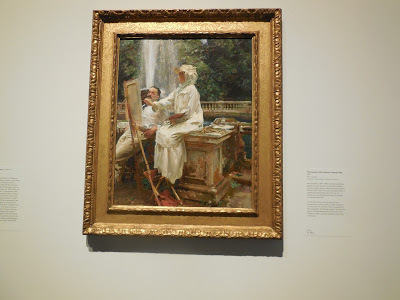 The Fountain, Villa Torlonia, Frascati, Italy, 1907
The Fountain, Villa Torlonia, Frascati, Italy, 1907
Jane de Glehn (1873-1961) is shown sketching outside Rome watched by her husband, Wilfred.
Further information on the Sargent Exhibition is here.
Following my visit to the exhibition, I went upstairs to the roof garden. It was a lovely day and the views were stunning across Central Park's lush greenery to the distant skyline.


Victoria here reporting on my recent visit to the wonderful exhibition at the Met, which was shown at the National Portrait Gallery in London last winter and spring..
 detail of Villa Torloni
detail of Villa TorloniFrom the introduction by the Met:
Throughout his career, the celebrated American painter John Singer Sargent (1856–1925) created portraits of artists, writers, actors, and musicians, many of whom were his close friends. Because these works were rarely commissioned, he was free to create images that were more radical than those he made for paying clients. He often posed these sitters informally—in the act of painting, singing, or performing, for example. Together, the portraits constitute a group of experimental paintings and drawings—some of them highly charged, others sensual, and some of them intimate, witty, or idiosyncratic. The exhibition Sargent: Portraits of Artists and Friends , which opened at The Metropolitan Museum of Art on June 30, brings together about 90 of these distinctive portraits, including numerous loans from private collections. It will also explore in depth the friendships between Sargent and those who posed for him as well as the significance of these relationships to his life and art.
 Metropolitan Museum of Art, Fifth Avenue
Metropolitan Museum of Art, Fifth AvenueI never tire of re-visiting the Met, and it is alwlays fun to snap new angles of the building.



On my way to the special exhibition, I encountered several posters, including a weirdly striking image from a photography exhibition.

Sargent was born of American parents in Florence, Italy, in 1856. He is best known for his portraits, in the grand traditions of Van Dyke, Reynolds, Gainsborough, and Lawrence. Like their work, his vivid portrayals of the rich and privileged, including their jewels, sumptuously painted fabrics, and noble backgrounds,were perfect for royalty. But these pictures are somewhat different, more experimental, even intimate. The people he painted in these works are his friends and colleagues, fellow members of the intellectual, theatrical, and artistic elite.
 Eager viewers around Sargent's portrait of Carolus-Durand, .
Eager viewers around Sargent's portrait of Carolus-Durand, .Early in the show is the portrait of Charles-Emile-Auguste Durand (1837-1917). with whom Sargent studied painting, beginning in 1874. According to the text panel, when this portrait of Durand by Sargent was exhibited at the Paris Salon in 1879, some remarked, "the student had surpassed the master."
 Carolus-Durand, 1879
Carolus-Durand, 1879Sargent painted the Pailleron family soon thereafter. The father was a playwright, the mother from an influential cultural family in France, and the daughter a literary figure much later.
 Edouard Pailleron, 1879
Edouard Pailleron, 1879 Madame Edouard Pailleron, 1879
Madame Edouard Pailleron, 1879 Edouard and Marie-Louise Pailleron, 1881
Edouard and Marie-Louise Pailleron, 1881This is an unusual double portrait, According to the text panel, "Sargent captures the young girl's disquieting intensity in an image that departs from the conventional Victorian representation of children, Her brother, seated at an angle on the far side of the settee, seems a secondary presence."
 Vernon Lee, 1881
Vernon Lee, 1881Using a pen name, Sargent's friend Violet Paget, was a "noted feminist and pacifist" as well a a woman of letters.publishing on aesthetics and psychology as well as authoring plays and novels.
 Madame X (Madame Pierre Gautreau) 1883-84
Madame X (Madame Pierre Gautreau) 1883-84Virginie Avegno Gautreau (1859-1915) from Louisiana was well-known in Parisian society for her daring appearance; Sargent emphasized her glamour in this portrait, which was first exhibited with one shoulder strap slipping down. The Paris Salon of 1884 was scandalized and Sargent re-painted the strap in its 'proper' place. A photograph of the original painting is shown with it.
 Claude Monet 1887
Claude Monet 1887Sargent and Monet (1840-1926) were friends and worked together sometimes. After Sargent moved to England in 1885, he followed Monet's example and began to paint outside, often portraying artist friends in a casual setting.
 Claude Monet Painting by the Edge of a Wood 1885
Claude Monet Painting by the Edge of a Wood 1885 Robert Louis Stevenson, 1887
Robert Louis Stevenson, 1887 Robert Louis Stevenson ad His Wife, 1885
Robert Louis Stevenson ad His Wife, 1885Stevenson (1850-1894) and Sargent were friends from early Paris days, and Sargent painted him three times. Of this view, Stevenson wrote it had "that witty touch of Sargent's, but of course it looks damn queer as a whole."
 Ellen Terry as Lady Macbeth, 1889
Ellen Terry as Lady Macbeth, 1889Sargent was impressed with famed Shakespearean actress Terry on the London stage in 1888 and convinced her to pose for him. She is pictured placing a crown on her own head after the murder of Duncan, the Scottish king. From the text panel: "This incident does not occur in Shakespeare's text, nor as it a part of the performance. Sargent, however, sought a dramatic motif to make his portrait convincing, both as the personification of a role,and as a characterization of an individual actor. Terry's intense and powerful gaze enhances the climactic moment."
 Self-portrait, 1906
Self-portrait, 1906Sargent was one of the first Americans to be invited to contribute a self-portrait to the collection of the prestigious Uffizi Gallery in Florence."His serious gaze befits the work's distinguished destination."
 Mrs. George Batten Singing, 1897
Mrs. George Batten Singing, 1897 Henry James, 1913
Henry James, 1913For his own self-portrait and that of Henry James, Sargent chose as sober straight-forward masterful method. When portraying Mrs. Batten singing, he is more creative, emphasizing her rapturous style.
 Ada Rehan, 1894-95
Ada Rehan, 1894-95Another renowned Shakespearean actress, Sargent portrays her in high style. As the text points out, "That Sargent shows her in the grand manner and scale typical of paintings of royalty, points to changing ideas of celebrity in the late nineteenth century."
 The Fountain, Villa Torlonia, Frascati, Italy, 1907
The Fountain, Villa Torlonia, Frascati, Italy, 1907Jane de Glehn (1873-1961) is shown sketching outside Rome watched by her husband, Wilfred.
Further information on the Sargent Exhibition is here.
Following my visit to the exhibition, I went upstairs to the roof garden. It was a lovely day and the views were stunning across Central Park's lush greenery to the distant skyline.


Published on August 31, 2015 00:30
August 24, 2015
150 YEARS OF ALICE IN WONDERLAND AT THE MORGAN LIBRARY
Victoria here. One of the highlights of my recent trip to New York City was the Morgan Library, the first time I had been there since the Renzo Piano addition. My photos, unless otherwise indicated.
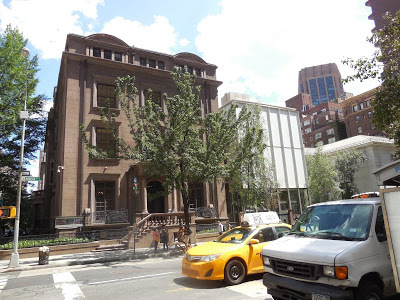 The Morgan Library with the House at left and glass Piano addition in the middle andthe Library on the far right, above the traffic
The Morgan Library with the House at left and glass Piano addition in the middle andthe Library on the far right, above the traffic

Above and below: the Renzo Piano Pavilion that unites the house, the library and the annex into an integrated whole. Adding to the effect of the brilliant light is the colorful display by artist Spencer Finch entitled A Certain Slant of Light, through August 23.
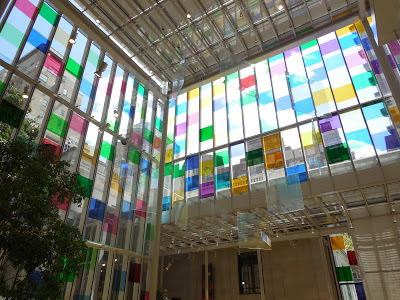
John Pierpont Morgan (1837-1913) was a banker, financier, and collector, and the descendant of several distinguished colonial and New England families. After his death, his son, J. P. Morgan Jr.(1867-1943), endowed a foundation to house and maintain his father's collections of manuscripts, books, and artwork. Today the oft-expanded library presents lectures, exhibitions, concerts, research facilities, and other programs for the public.
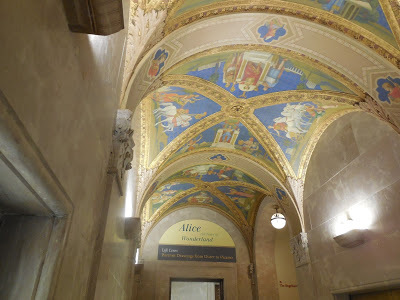
I was eager to see the exhibition Alice: 150 Years of Wonderland. The Exhibition website is here.
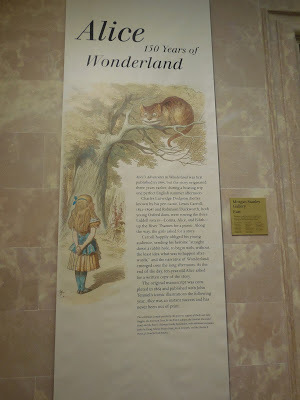 On display at the Morgan Library through October 11, 2015
On display at the Morgan Library through October 11, 2015
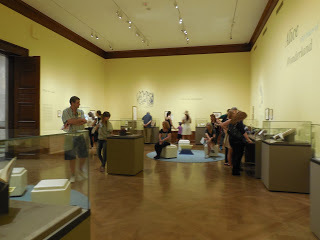 In the exhibit
In the exhibit
As the text panels tell us, Alice in Wonderland was first published in 1865 by Lewis Carroll, pen name of Charles Lutwidge Dodgson, three years after he told the story to Alice Liddell on a summer boating trip from Oxford. Alice asked him to write out the story of Alice's odd adventures, and after three years of writing and expanding the story, he had it self-published with illustrations by Sir John Tenniel. It was temporarily withdrawn because the pictures were poorly reproduced, but after re-publication, it has never been out of print.
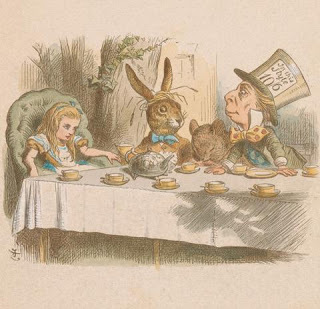 John Tenniel (1820–1914) “Why is a raven like a writing-desk?”Hand-colored proof, 1885 The Morgan Library and Museum, New York. gift of Arthur A. Houghton, Jr., Photography by Steven H. Crossot, 2014.
John Tenniel (1820–1914) “Why is a raven like a writing-desk?”Hand-colored proof, 1885 The Morgan Library and Museum, New York. gift of Arthur A. Houghton, Jr., Photography by Steven H. Crossot, 2014.
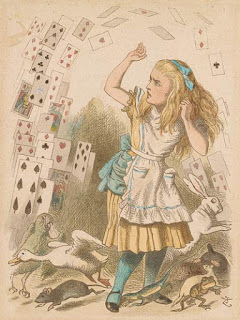 John Tenniel (1820–1914), Nothing but a pack of cards! 1885, Hand-colored proof. Gift of Arthur A. Houghton, Jr., The Morgan Library and Museum, Photography by Steven H. Crossot, 2014.
John Tenniel (1820–1914), Nothing but a pack of cards! 1885, Hand-colored proof. Gift of Arthur A. Houghton, Jr., The Morgan Library and Museum, Photography by Steven H. Crossot, 2014.
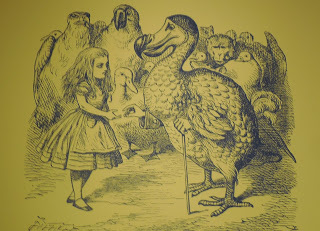 Illustrations are reproduced on the walls; Alice and the Dodo
Illustrations are reproduced on the walls; Alice and the Dodo
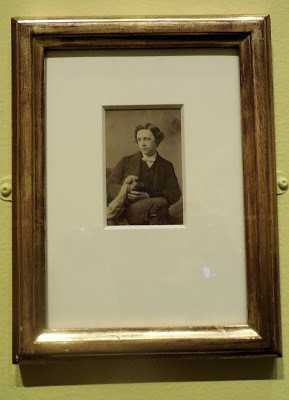 Charles Dodgson
Charles Dodgson
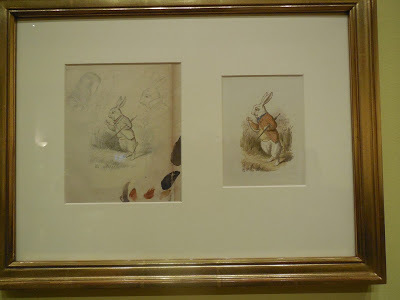 Preparatory drawing and published version of the White Rabbit by Tenniel in the first edition
Preparatory drawing and published version of the White Rabbit by Tenniel in the first edition
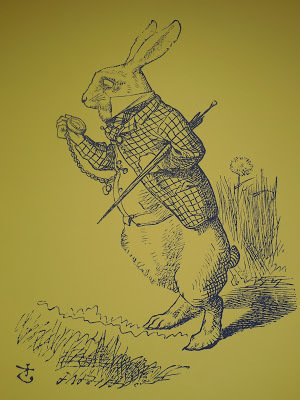 The White Rabbit
The White Rabbit
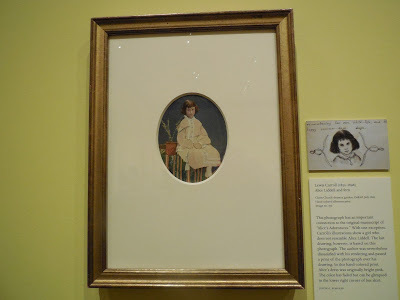 Alice Liddell in a photo and in Dodgson's drawing at right
Alice Liddell in a photo and in Dodgson's drawing at right
I couldn't resist walking around in the historic library where Pierpont Morgan collected his manuscripts, books, and art.
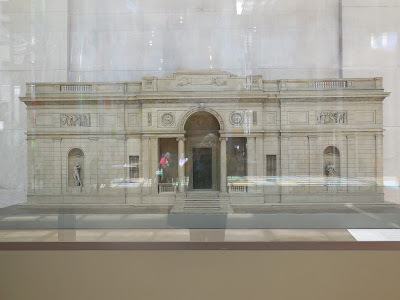 Drawing of the front elevation of the Library built by Charles McKim (1847-1909), completed in 1906
Drawing of the front elevation of the Library built by Charles McKim (1847-1909), completed in 1906
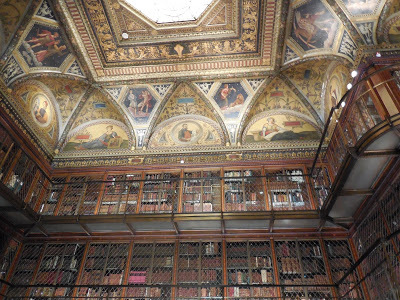 The magnificent library (East Room)
The magnificent library (East Room)
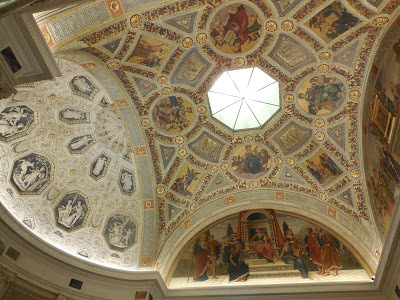 Rotunda
Rotunda
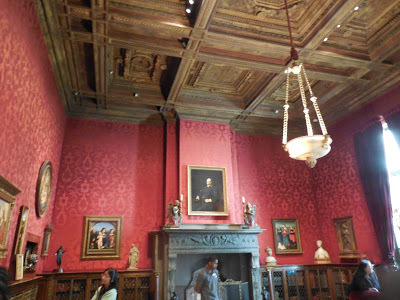 The Study, where children were getting a briefing on the library
The Study, where children were getting a briefing on the library
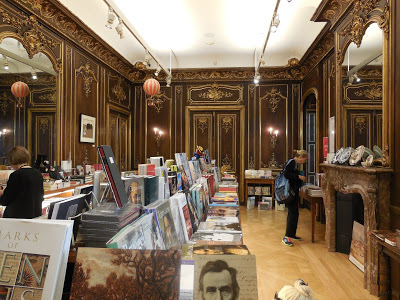 part of the well-stocked gift and book shop (in the old house)
part of the well-stocked gift and book shop (in the old house)
To shop on line, click here.
 The Morgan Library with the House at left and glass Piano addition in the middle andthe Library on the far right, above the traffic
The Morgan Library with the House at left and glass Piano addition in the middle andthe Library on the far right, above the traffic
Above and below: the Renzo Piano Pavilion that unites the house, the library and the annex into an integrated whole. Adding to the effect of the brilliant light is the colorful display by artist Spencer Finch entitled A Certain Slant of Light, through August 23.

John Pierpont Morgan (1837-1913) was a banker, financier, and collector, and the descendant of several distinguished colonial and New England families. After his death, his son, J. P. Morgan Jr.(1867-1943), endowed a foundation to house and maintain his father's collections of manuscripts, books, and artwork. Today the oft-expanded library presents lectures, exhibitions, concerts, research facilities, and other programs for the public.

I was eager to see the exhibition Alice: 150 Years of Wonderland. The Exhibition website is here.
 On display at the Morgan Library through October 11, 2015
On display at the Morgan Library through October 11, 2015 In the exhibit
In the exhibitAs the text panels tell us, Alice in Wonderland was first published in 1865 by Lewis Carroll, pen name of Charles Lutwidge Dodgson, three years after he told the story to Alice Liddell on a summer boating trip from Oxford. Alice asked him to write out the story of Alice's odd adventures, and after three years of writing and expanding the story, he had it self-published with illustrations by Sir John Tenniel. It was temporarily withdrawn because the pictures were poorly reproduced, but after re-publication, it has never been out of print.
 John Tenniel (1820–1914) “Why is a raven like a writing-desk?”Hand-colored proof, 1885 The Morgan Library and Museum, New York. gift of Arthur A. Houghton, Jr., Photography by Steven H. Crossot, 2014.
John Tenniel (1820–1914) “Why is a raven like a writing-desk?”Hand-colored proof, 1885 The Morgan Library and Museum, New York. gift of Arthur A. Houghton, Jr., Photography by Steven H. Crossot, 2014. John Tenniel (1820–1914), Nothing but a pack of cards! 1885, Hand-colored proof. Gift of Arthur A. Houghton, Jr., The Morgan Library and Museum, Photography by Steven H. Crossot, 2014.
John Tenniel (1820–1914), Nothing but a pack of cards! 1885, Hand-colored proof. Gift of Arthur A. Houghton, Jr., The Morgan Library and Museum, Photography by Steven H. Crossot, 2014. Illustrations are reproduced on the walls; Alice and the Dodo
Illustrations are reproduced on the walls; Alice and the Dodo Charles Dodgson
Charles Dodgson  Preparatory drawing and published version of the White Rabbit by Tenniel in the first edition
Preparatory drawing and published version of the White Rabbit by Tenniel in the first edition The White Rabbit
The White Rabbit Alice Liddell in a photo and in Dodgson's drawing at right
Alice Liddell in a photo and in Dodgson's drawing at rightI couldn't resist walking around in the historic library where Pierpont Morgan collected his manuscripts, books, and art.
 Drawing of the front elevation of the Library built by Charles McKim (1847-1909), completed in 1906
Drawing of the front elevation of the Library built by Charles McKim (1847-1909), completed in 1906  The magnificent library (East Room)
The magnificent library (East Room) Rotunda
Rotunda The Study, where children were getting a briefing on the library
The Study, where children were getting a briefing on the library part of the well-stocked gift and book shop (in the old house)
part of the well-stocked gift and book shop (in the old house)To shop on line, click here.
Published on August 24, 2015 00:30
August 21, 2015
DUKE OF WELLINGTON TOUR REPORTS....BACK SOON.
We'll return shortly with lots more posts re-living our Duke of Wellington Tour....just a short break at the tale end of another summer. Last year at this time we were preparing to start the tour...now it is memory- and picture-time,
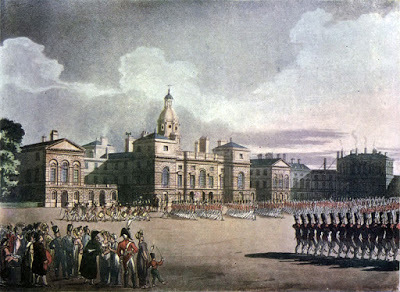 "Mounting Guard, St. James's Park" (Horse Guards Parade) 1809from Microcosm of London
"Mounting Guard, St. James's Park" (Horse Guards Parade) 1809from Microcosm of London
Thanks for your patience,,,Kristine and Victoria
 "Mounting Guard, St. James's Park" (Horse Guards Parade) 1809from Microcosm of London
"Mounting Guard, St. James's Park" (Horse Guards Parade) 1809from Microcosm of LondonThanks for your patience,,,Kristine and Victoria
Published on August 21, 2015 00:30
August 19, 2015
August 17, 2015
JESS RUSSELL AND THE DRESSMAKER'S DUKE
Victoria here, bringing you the delightful story of Jess Russell, who opted for historical accuracy to the extent that she fashioned her own regency gown, sometimes working by candlelight, to know what a regency dressmaker would have experienced.
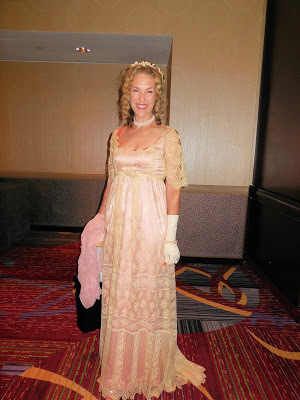 DRESSMAKER JESS RUSSELL
DRESSMAKER JESS RUSSELL
I met Jess at the Beau Monde's 2015 Regency Writers Conference and Soiree, where she appeared (above) in her lovely creation. All of us were wowed in the best 21st century tradition!
Jess is the author of the best-selling novel The Dressmaker's Duke. To Read more about Jess and her novel, click here.
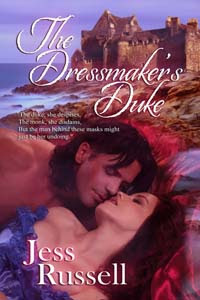
Jess agreed to tell the story of her novel and her gown for this blog. She writes:
In The Dressmaker’s Duke, my Heroine, Olivia Weston, is (surprise, a dressmaker. To help launch the book I decided to create a Regency gown from scratch, just as Olivia would have done.
Imagine sewing everything by hand, in poor light, without even a dress form. And then, after working your fingers to the bone creating this stunning gown, you can’t even get your rich client to pay up. Well, my poor heroine goes through such a trial. The good news is her money troubles throw her smack up against my monkish, but oh-so-sexy Duke.
So, I thought it only fitting that as Olivia’s creator, I should have to step into her slippers.
Below is the finished gown~
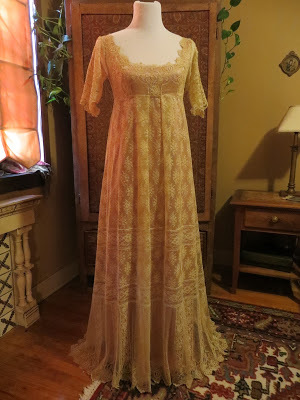
And now me modeling~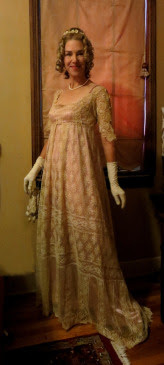
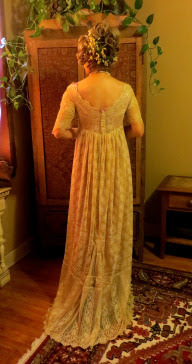
Things I learned making this gown~1. Hand sewing a simple straight seam takes about 7 x’s longer than using a machine.2. Use a thimble if you can master it. Your fingertips will thank you. (I ended up using the finge
tip of an old leather glove.)3. Approximately 29 hours spent sewing.4. Approximately the same number of threaded needles used.5. Back stitch! If you have to cut the fabric and have used a back stitch you won’t lose all your
stitches.6. Run your thread through bees wax. This helps the thread from snarling.7. It is EXTREMELY hard to rip out when sewing lace. All the threads look alike.8. It is surprisingly hard to sew in a straight line.9. My best running stitch was 14 stitches per inch.10. I now have arthritis in my pinkie finger.11. Good lighting is paramount! Not easy when you are trying to sew by candlelight. Seamstresses
must have had very tired eyes.
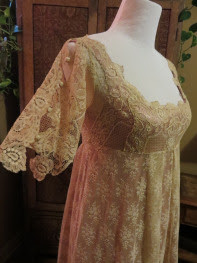
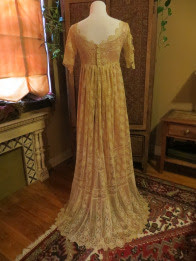
Things I learned wearing this gown at the Beau Monde Soiree~1. It is surprisingly comfortable.2. These light gowns must have been lovely in the summer, but brutal in winter in a chilly castle.3. You have to be aware of the blasted train at all times! I would think it’s much like driving;
you have to watch out for not only you, but the other drivers as well. (I can’t imagine
negotiating a crowded ball room. No wonder there was always a maid installed in the “ladies
retiring room” to mend ripped hems.)4. Country dances are exhausting but great FUN! 5. You cannot do a darned thing when wearing gloves. And taking them on and off can be a
painstaking task.
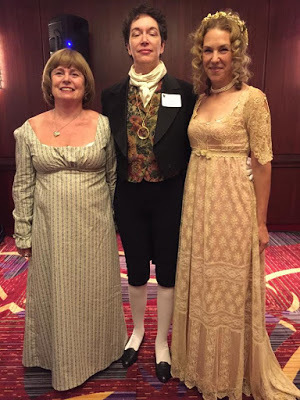 At the Beau Monde Soiree, L to R: Ann, Sir Reggie, Jess
At the Beau Monde Soiree, L to R: Ann, Sir Reggie, Jess
I made the over-dress out of an old bed canopy. Re-purposing this piece of lace inspired my blog called “Trash to Treasure.” Each month I transform a thrift store find into something new and exciting! You can find me at://jessrussellromance.com/
For a sneak peak here is my Mid-century evening coat re-made into a 19th century Redingote!
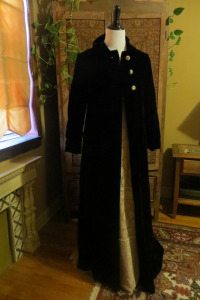
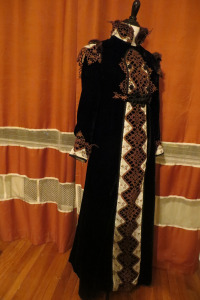
The Dressmaker’s Duke was a double finalist in the National Readers Choice Awards for Best First Book and Best Historical and is available at Amazon, iTunes, and BandN.
Thanks so much for having me share my love of sewing! Jess Russell
Victoria again. Thanks so much for sharing your experiences, Jess. And just to remind readers of this blog and not incidentally myself (!) -- all us us who thinks this might be easy -- Jess adds:
I have been sewing since I was very young. So when I embarked on my first novel the phrase “write what you know” came to mind. Well, I know sewing. Here is my wedding gown. The pattern I made out of newspaper and the rest I made up as I went along.
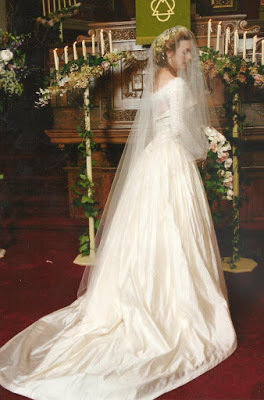 Jess in her bridal gown
Jess in her bridal gown
Again, all I can say is wow!! Even if I were an experienced stitcher, I could not begin to imagine creating such a fabulous dress!! Brava, Jess.
 DRESSMAKER JESS RUSSELL
DRESSMAKER JESS RUSSELLI met Jess at the Beau Monde's 2015 Regency Writers Conference and Soiree, where she appeared (above) in her lovely creation. All of us were wowed in the best 21st century tradition!
Jess is the author of the best-selling novel The Dressmaker's Duke. To Read more about Jess and her novel, click here.

Jess agreed to tell the story of her novel and her gown for this blog. She writes:
In The Dressmaker’s Duke, my Heroine, Olivia Weston, is (surprise, a dressmaker. To help launch the book I decided to create a Regency gown from scratch, just as Olivia would have done.
Imagine sewing everything by hand, in poor light, without even a dress form. And then, after working your fingers to the bone creating this stunning gown, you can’t even get your rich client to pay up. Well, my poor heroine goes through such a trial. The good news is her money troubles throw her smack up against my monkish, but oh-so-sexy Duke.
So, I thought it only fitting that as Olivia’s creator, I should have to step into her slippers.
Below is the finished gown~

And now me modeling~


Things I learned making this gown~1. Hand sewing a simple straight seam takes about 7 x’s longer than using a machine.2. Use a thimble if you can master it. Your fingertips will thank you. (I ended up using the finge
tip of an old leather glove.)3. Approximately 29 hours spent sewing.4. Approximately the same number of threaded needles used.5. Back stitch! If you have to cut the fabric and have used a back stitch you won’t lose all your
stitches.6. Run your thread through bees wax. This helps the thread from snarling.7. It is EXTREMELY hard to rip out when sewing lace. All the threads look alike.8. It is surprisingly hard to sew in a straight line.9. My best running stitch was 14 stitches per inch.10. I now have arthritis in my pinkie finger.11. Good lighting is paramount! Not easy when you are trying to sew by candlelight. Seamstresses
must have had very tired eyes.


Things I learned wearing this gown at the Beau Monde Soiree~1. It is surprisingly comfortable.2. These light gowns must have been lovely in the summer, but brutal in winter in a chilly castle.3. You have to be aware of the blasted train at all times! I would think it’s much like driving;
you have to watch out for not only you, but the other drivers as well. (I can’t imagine
negotiating a crowded ball room. No wonder there was always a maid installed in the “ladies
retiring room” to mend ripped hems.)4. Country dances are exhausting but great FUN! 5. You cannot do a darned thing when wearing gloves. And taking them on and off can be a
painstaking task.
 At the Beau Monde Soiree, L to R: Ann, Sir Reggie, Jess
At the Beau Monde Soiree, L to R: Ann, Sir Reggie, JessI made the over-dress out of an old bed canopy. Re-purposing this piece of lace inspired my blog called “Trash to Treasure.” Each month I transform a thrift store find into something new and exciting! You can find me at://jessrussellromance.com/
For a sneak peak here is my Mid-century evening coat re-made into a 19th century Redingote!


The Dressmaker’s Duke was a double finalist in the National Readers Choice Awards for Best First Book and Best Historical and is available at Amazon, iTunes, and BandN.
Thanks so much for having me share my love of sewing! Jess Russell
Victoria again. Thanks so much for sharing your experiences, Jess. And just to remind readers of this blog and not incidentally myself (!) -- all us us who thinks this might be easy -- Jess adds:
I have been sewing since I was very young. So when I embarked on my first novel the phrase “write what you know” came to mind. Well, I know sewing. Here is my wedding gown. The pattern I made out of newspaper and the rest I made up as I went along.
 Jess in her bridal gown
Jess in her bridal gownAgain, all I can say is wow!! Even if I were an experienced stitcher, I could not begin to imagine creating such a fabulous dress!! Brava, Jess.
Published on August 17, 2015 00:30
August 14, 2015
AN INTERRUPTION: THE DUKE OF WELLINGTON TOUR REPORTS WILL RESUME SOON.
AN INTERRUPTION: THE DUKE OF WELLINGTON TOUR REPORTS WILL RESUME SOON.
Next, our visit to the Regency Town House in Hove.
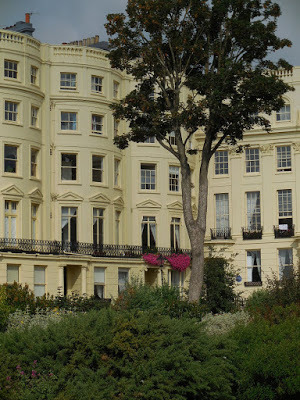 Brunswick Square, Hove
Brunswick Square, Hove
Next, our visit to the Regency Town House in Hove.
 Brunswick Square, Hove
Brunswick Square, Hove
Published on August 14, 2015 00:30
August 12, 2015
WATERLOO WEDNESDAYS: A BRIEF HIATUS
PLEASE EXCUSE US FOR TAKING A BRIEF SUMMER HIATUS ON WATERLOO WEDNESDAYS. WE STILL HAVE MUCH MORE TO REPORT, RESUMING SHORTLY.
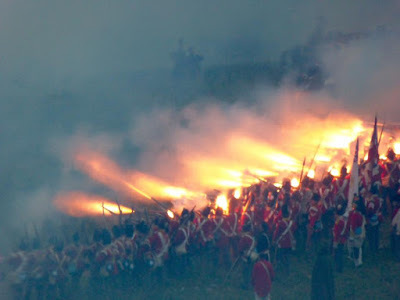 FROM REPORTS ON THE 2015 BICENTENARY RE-ENACTMENT
FROM REPORTS ON THE 2015 BICENTENARY RE-ENACTMENT
IN THE MEANTIME, ENJOY A REPORT ON TWO SHARP(E)S -- WATERLOO IN FICTION FROM HISTORY TODAY: Click here
 FROM REPORTS ON THE 2015 BICENTENARY RE-ENACTMENT
FROM REPORTS ON THE 2015 BICENTENARY RE-ENACTMENTIN THE MEANTIME, ENJOY A REPORT ON TWO SHARP(E)S -- WATERLOO IN FICTION FROM HISTORY TODAY: Click here
Published on August 12, 2015 00:30
August 10, 2015
HENRY CYRIL PAGET, 5TH MARQUESS OF ANGELSEY
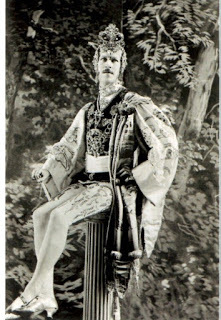
Called The Mad Marquess or, less frequently, the Dancing Marquess, Henry Cyril Paget, 5th Marquess of Angelsey, could not have been more different from his illustrious ancestor, Henry William Paget, the 1st Marquess, if he'd tried. Whilst the 1st Marquess lost his leg at Waterloo, the 5th lost a fortune on a lavish, over-the-top lifestyle that nearly bankrupted the estate. The 5th Marquess collected clothing and jewels with gusto and had his motor car fitted with pipes that issued wafts of perfume instead of exhaust fumes. The 5th Marquess's excesses scandalized the locals who lived near Plas Newydd, the Angelsey home of the Paget family, as they did the entire nation, but the final straw came when he had the family chapel converted into his own private theatre.
The Marquess was described by Clough Williams-Ellis as “a sort of apparition – a tall, elegant and bejeweled creature, with wavering elegant gestures, reminding one rather of an Aubrey Beardsley illustration come to life.” An Omaha newspaper described him thus: “He is a thoroughly effeminate looking young fellow and he may be seen when in Paris walking around with a toy terrier under his arm, the pet being heavily scented and bedizened with bangles and bows. The fingers of the marquis fairly blaze with rings. He presents the characteristics of the Gypsy type.”
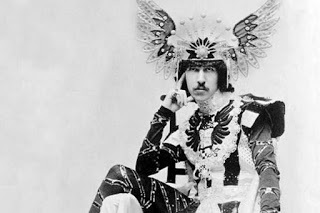
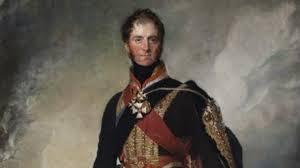
As I said, the 1st and 5th Marquess's couldn't be more different, although they do appear to share the same smile. Viv Gardner, Professor of Theatre Studies at the University of Manchester, is recognized as an expert on the life and times of the 5th Marquess and so we turn to her article on the subject that appeared in The Guardian in 2007 for more background information:
"The recorded facts about Paget are fragmentary and elusive; the suppositions are numberless. What we do know is that Henry Cyril Paget was born in Paris on June 16 1875 to Henry Paget, Earl of Uxbridge, later 4th Marquis of Anglesey, and his wife, Blanche Mary Curwen Boyd. They had married in 1874, and Paget's mother died when he was scarcely two years old. On her death, he went to live with the French actor Benoît-Constant Coquelin - who was rumoured to be his real father. Paget referred to Coquelin's sister as his aunt throughout his life, and she was with him when he died.At the age of eight, Paget left Paris and was taken to live at Plas Newydd, his father having married for a third time, to an American heiress. His childhood in north Wales seems to have been particularly isolated. Paget missed his own lavish, week-long 21st birthday celebrations due to ill health, and a cold could put him to bed for weeks. He learned painting and singing in Germany and spoke fluent French, good Russian and grammatical Welsh. At some time, rather incredibly, he also served as a lieutenant in the 2nd Volunteer Battalion of the Royal Welsh Fusiliers.In 1898, Paget married his cousin, Lilian Chetwynd. The marriage was annulled two years later - stories abound as to why - but the annulment was changed to a legal separation in 1901. He succeeded to the title of 5th Marquis in 1898, and inherited substantial property on Anglesey and in Staffordshire, with an annual income of over £110,000 a year (roughly £8m in today's money).By 1904, however, the Marquis had bankrupted the estate, spending thousands of pounds on jewels, furs, cars, boats, perfumes and potions, toys, medicines, dogs, horses and theatricals on a scale unimagined even among the profligate Edwardian aristocracy. Everything was sold to meet his debts, down to the contents of the potting shed and a parrot in a brass cage.Paget "retired" to France on an income of £3,000 a year, accompanied only by a manservant, his adopted child (a dark-skinned baby who was later returned to her birth parents) and her nurse. They went first to Dinan in Brittany, and finally to Monte Carlo, where Paget died in 1905, his former wife and Mme Coquelin at his bedside.Most of the Marquis's effects were sold from his family estates soon after he was declared bankrupt, and all his personal papers were destroyed by the Paget family after his death. Even today, the family are reticent about their forebear, who brought devastation and distress not just to the Pagets and their property, but to their servants, tenants, neighbours and tradesmen."
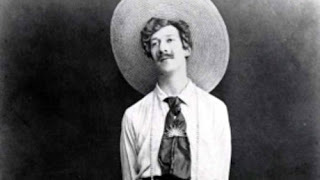
More information on the 5th Marquess can be found at the irreverant and most amsuing site, Bizarre Victoria and in this article written by a National Trust intern, intriguingly titled The Emerald Encrusted Wiff-Waff Jacket. Finally, you can listen to a half hour radio programmed on the 5th Marquess and all his eccentricities here at the BBC Radio 4 site.
Published on August 10, 2015 00:00
Kristine Hughes's Blog
- Kristine Hughes's profile
- 6 followers
Kristine Hughes isn't a Goodreads Author
(yet),
but they
do have a blog,
so here are some recent posts imported from
their feed.



























